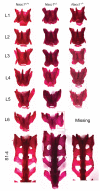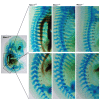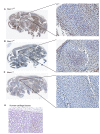Loss of NAC1 expression is associated with defective bony patterning in the murine vertebral axis
- PMID: 23922682
- PMCID: PMC3724875
- DOI: 10.1371/journal.pone.0069099
Loss of NAC1 expression is associated with defective bony patterning in the murine vertebral axis
Abstract
NAC1 encoded by NACC1 is a member of the BTB/POZ family of proteins and participates in several pathobiological processes. However, its function during tissue development has not been elucidated. In this study, we compared homozygous null mutant Nacc1(-/-) and wild type Nacc1(+/+) mice to determine the consequences of diminished NAC1 expression. The most remarkable change in Nacc1(-/-) mice was a vertebral patterning defect in which most knockout animals exhibited a morphological transformation of the sixth lumbar vertebra (L6) into a sacral identity; thus, the total number of pre-sacral vertebrae was decreased by one (to 25) in Nacc1(-/-) mice. Heterozygous Nacc1(+/-) mice had an increased tendency to adopt an intermediate phenotype in which L6 underwent partial sacralization. Nacc1(-/-) mice also exhibited non-closure of the dorsal aspects of thoracic vertebrae T10-T12. Chondrocytes from Nacc1(+/+) mice expressed abundant NAC1 while Nacc1(-/-) chondrocytes had undetectable levels. Loss of NAC1 in Nacc1(-/-) mice was associated with significantly reduced chondrocyte migratory potential as well as decreased expression of matrilin-3 and matrilin-4, two cartilage-associated extracellular matrix proteins with roles in the development and homeostasis of cartilage and bone. These data suggest that NAC1 participates in the motility and differentiation of developing chondrocytes and cartilaginous tissues, and its expression is necessary to maintain normal axial patterning of murine skeleton.
Conflict of interest statement
Figures








References
-
- Stead MA, Carr SB, Wright SC (2009) Structure of the human Nac1 POZ domain. Acta Crystallogr Sect Struct Biol Cryst Commun 65: 445-449. doi:10.1107/S0108768109024161. PubMed: 19407373. - DOI - PMC - PubMed
-
- Korutla L, Wang PJ, Lewis DM, Neustadter JH, Stromberg MF et al. (2002) Differences in expression, actions and cocaine regulation of two isoforms for the brain transcriptional regulator NAC1. Neuroscience 110: 421-429. doi:10.1016/S0306-4522(01)00518-8. PubMed: 11906783. - DOI - PubMed
-
- Mackler S, Pacchioni A, Degnan R, Homan Y, Conti AC et al. (2008) Requirement for the POZ/BTB protein NAC1 in acute but not chronic psychomotor stimulant response. Behav Brain Res 187: 48-55. doi:10.1016/j.bbr.2007.08.036. PubMed: 17945361. - DOI - PMC - PubMed
-
- Mancini C, Messana E, Turco E, Brussino A, Brusco A (2011) Gene-targeted embryonic stem cells: real-time PCR assay for estimation of the number of neomycin selection cassettes. Biol Proced Online 13: 10. doi:10.1186/1480-9222-13-10. PubMed: 22035318. - DOI - PMC - PubMed
Publication types
MeSH terms
Substances
Grants and funding
LinkOut - more resources
Full Text Sources
Other Literature Sources
Molecular Biology Databases
Research Materials

